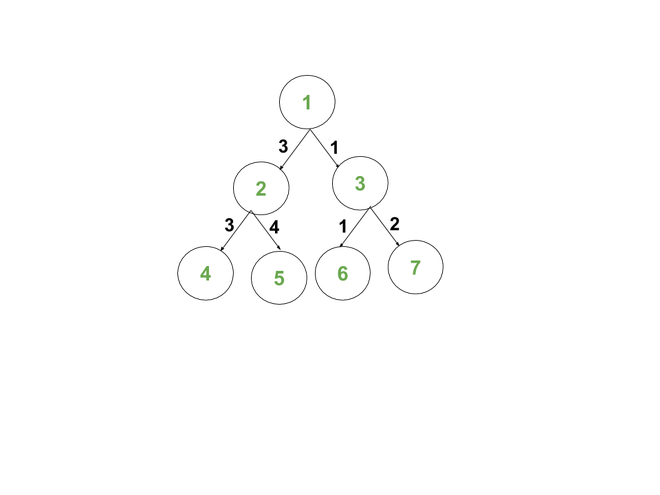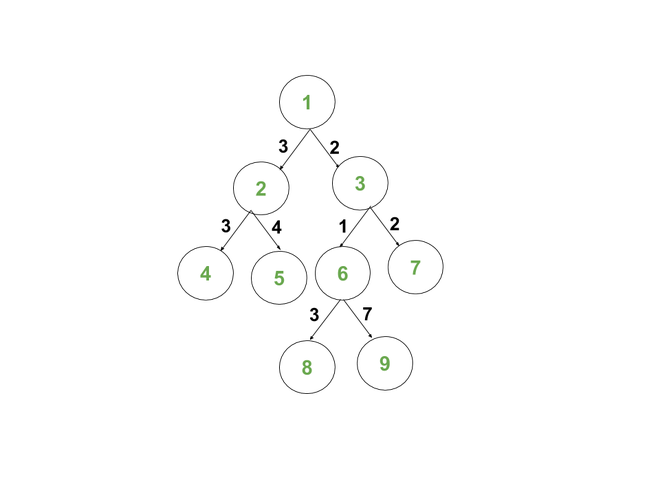给定一个由N 个节点和两个整数R和K组成的二叉树。树的每条边都有一个与之关联的正整数,以{u, v, w}的形式给出,其中边(u, v) 的权重为w 。任务是计算从根R到S的路径中所有边的按位异或的节点数S等于K 。
例子:
Input: R = 1, K = 0, N = 7, Edges[][] = {{1, 2, 3}, {1, 3, 1}, {2, 4, 3}, {2, 5, 4}, {3, 6, 1}, {3, 7, 2}}
Output: 2
Explanation:
Representation of the given Binary Tree:

The following pair of nodes have a Bitwise XOR of edges in the path connecting them as K = 0:
Pair 1: (1, 4) = (3 ^ 3) = 0
Pair 2: (1, 6) = (1 ^ 1) = 0
Input: R = 1, K = 0, N = 9, Edges[][] = {{1, 2, 3}, {1, 3, 2}, {2, 4, 3}, {2, 5, 4}, {3, 6, 1}, {3, 7, 2}, {6, 8, 3}, {6, 9, 7}}
Output: 3
Explanation:
The representation of given Binary Tree is as follows:

The following pair of nodes have a Bitwise XOR of edges in the path connecting them as K = 0:
Pair 1: (1, 4) = (3 ^ 3) = 0
Pair 2: (1, 8) = (2 ^ 1 ^ 3) = 0
Pair 3: (1, 7) = (2 ^ 2) = 0
方法:该问题可以使用深度优先搜索方法解决。请按照以下步骤解决问题:
- 用0初始化变量ans和xor以存储对的数量和边的当前 xor。
- 使用深度优先搜索从给定的根顶点R开始遍历给定的树。
- 对于每个节点u ,访问其相邻节点。
- 对于每条边{u, v} ,如果xor等于K ,则将ans增加1 。否则,当前边缘{U,V,W},更新XOR为异或=(XOR ^ W)其中,^是逐位异或。
- 遍历后,将存储在计数器ans 中的值打印为对数。
下面是上述方法的实现:
C++
// C++ program for the above approach
#include
using namespace std;
// Initialize the adjacency list
// to represent the tree
vector > adj[100005];
// Marks visited / unvisited vertices
int visited[100005] = { 0 };
// Stores the required count of nodes
int ans = 0;
// DFS to visit each vertex
void dfs(int node, int xorr, int k)
{
// Mark the current node
// as visited
visited[node] = 1;
// Update the counter xor is K
if (node != 1 && xorr == k)
ans++;
// Visit adjacent nodes
for (auto x : adj[node]) {
if (!visited[x.first]) {
// Calculate Bitwise XOR of
// edges in the path
int xorr1 = xorr ^ x.second;
// Recursive call to dfs function
dfs(x.first, xorr1, k);
}
}
}
// Function to construct the tree and
// print required count of nodes
void countNodes(int N, int K, int R,
vector > edges)
{
// Add edges
for (int i = 0; i < N - 1; i++) {
int u = edges[i][0], v = edges[i][1],
w = edges[i][2];
adj[u].push_back({ v, w });
adj[v].push_back({ u, w });
}
dfs(R, 0, K);
// Print answer
cout << ans << "\n";
}
// Driver Code
int main()
{
// Given K and R
int K = 0, R = 1;
// Given edges
vector > edges
= { { 1, 2, 3 }, { 1, 3, 1 },
{ 2, 4, 3 }, { 2, 5, 4 },
{ 3, 6, 1 }, { 3, 7, 2 } };
// Number of vertices
int N = edges.size();
// Function call
countNodes(N, K, R, edges);
return 0;
} Java
// Java program for the
// above approach
import java.util.*;
class GFG{
static class pair
{
int first, second;
public pair(int first,
int second)
{
this.first = first;
this.second = second;
}
}
// Initialize the adjacency list
// to represent the tree
static Vector []adj =
new Vector[100005];
// Marks visited / unvisited
// vertices
static int visited[] =
new int[100005];
// Stores the required
// count of nodes
static int ans = 0;
// DFS to visit each
// vertex
static void dfs(int node,
int xorr,
int k)
{
// Mark the current node
// as visited
visited[node] = 1;
// Update the counter
// xor is K
if (node != 1 &&
xorr == k)
ans++;
// Visit adjacent nodes
for (pair x : adj[node])
{
if (visited[x.first] != 1)
{
// Calculate Bitwise XOR of
// edges in the path
int xorr1 = xorr ^ x.second;
// Recursive call to dfs
// function
dfs(x.first, xorr1, k);
}
}
}
// Function to conthe tree and
// print required count of nodes
static void countNodes(int N, int K,
int R, int[][] edges)
{
// Add edges
for (int i = 0; i < N - 1; i++)
{
int u = edges[i][0],
v = edges[i][1],
w = edges[i][2];
adj[u].add(new pair(v, w ));
adj[v].add(new pair(u, w ));
}
dfs(R, 0, K);
// Print answer
System.out.print(ans + "\n");
}
// Driver Code
public static void main(String[] args)
{
// Given K and R
int K = 0, R = 1;
for (int i = 0; i < adj.length; i++)
adj[i] = new Vector();
// Given edges
int[][] edges = {{1, 2, 3},
{1, 3, 1},
{2, 4, 3},
{2, 5, 4},
{3, 6, 1},
{3, 7, 2}};
// Number of vertices
int N = edges.length;
// Function call
countNodes(N, K, R, edges);
}
}
// This code is contributed by 29AjayKumar Python3
# Python3 program for the above approach
# Initialize the adjacency list
# to represent the tree
adj = [[] for i in range(100005)]
# Marks visited / unvisited vertices
visited = [0] * 100005
# Stores the required count of nodes
ans = 0
# DFS to visit each vertex
def dfs(node, xorr, k):
global ans
# Mark the current node
# as visited
visited[node] = 1
# Update the counter xor is K
if (node != 1 and xorr == k):
ans += 1
# Visit adjacent nodes
for x in adj[node]:
if (not visited[x[0]]):
# Calculate Bitwise XOR of
# edges in the path
xorr1 = xorr ^ x[1]
# Recursive call to dfs function
dfs(x[0], xorr1, k)
# Function to construct the tree and
# prrequired count of nodes
def countNodes(N, K, R, edges):
# Add edges
for i in range(N - 1):
u = edges[i][0]
v = edges[i][1]
w = edges[i][2]
adj[u].append([v, w])
adj[v].append([u, w])
dfs(R, 0, K)
# Print answer
print(ans)
# Driver Code
if __name__ == '__main__':
# Given K and R
K = 0
R = 1
# Given edges
edges = [ [ 1, 2, 3 ],[ 1, 3, 1 ],
[ 2, 4, 3 ],[ 2, 5, 4 ],
[ 3, 6, 1 ],[ 3, 7, 2 ] ]
# Number of vertices
N = len(edges)
# Function call
countNodes(N, K, R, edges)
# This code is contributed by mohit kumar 29C#
// C# program for the
// above approach
using System;
using System.Collections.Generic;
class GFG{
public class pair
{
public int first,
second;
public pair(int first,
int second)
{
this.first = first;
this.second = second;
}
}
// Initialize the adjacency list
// to represent the tree
static List []adj =
new List[100005];
// Marks visited / unvisited
// vertices
static int []visited =
new int[100005];
// Stores the required
// count of nodes
static int ans = 0;
// DFS to visit each
// vertex
static void dfs(int node,
int xorr,
int k)
{
// Mark the current node
// as visited
visited[node] = 1;
// Update the counter
// xor is K
if (node != 1 &&
xorr == k)
ans++;
// Visit adjacent nodes
foreach (pair x in adj[node])
{
if (visited[x.first] != 1)
{
// Calculate Bitwise XOR of
// edges in the path
int xorr1 = xorr ^ x.second;
// Recursive call to dfs
// function
dfs(x.first, xorr1, k);
}
}
}
// Function to conthe tree and
// print required count of nodes
static void countNodes(int N, int K,
int R, int[,] edges)
{
// Add edges
for (int i = 0; i < N - 1; i++)
{
int u = edges[i,0];
int v = edges[i,1],
w = edges[i,2];
adj[u].Add(new pair(v, w ));
adj[v].Add(new pair(u, w ));
}
dfs(R, 0, K);
// Print answer
Console.Write(ans + "\n");
}
// Driver Code
public static void Main(String[] args)
{
// Given K and R
int K = 0, R = 1;
for (int i = 0; i < adj.Length; i++)
adj[i] = new List();
// Given edges
int[,] edges = {{1, 2, 3},
{1, 3, 1},
{2, 4, 3},
{2, 5, 4},
{3, 6, 1},
{3, 7, 2}};
// Number of vertices
int N = edges.GetLength(0);
// Function call
countNodes(N, K, R, edges);
}
}
// This code is contributed by 29AjayKumar Javascript
2时间复杂度: O(N),其中N是节点数。
辅助空间: O(N)
如果您希望与专家一起参加现场课程,请参阅DSA 现场工作专业课程和学生竞争性编程现场课程。